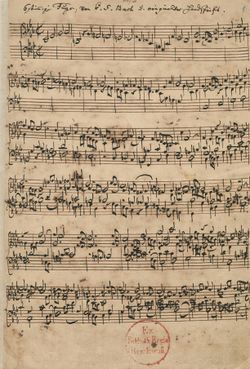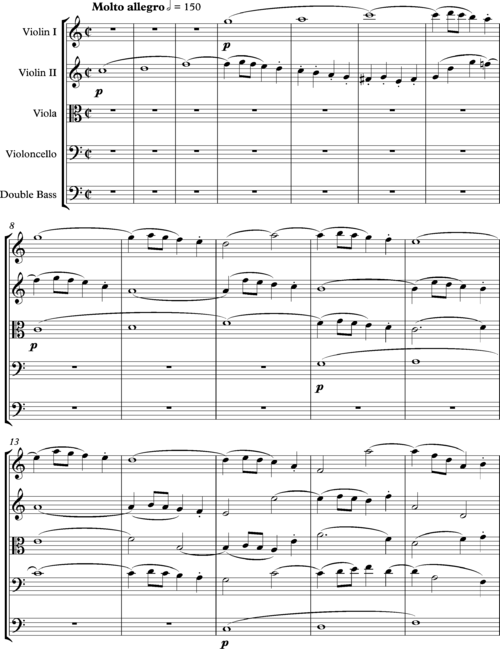فوگا

فوگا أو فيوگ (باللاتينية: fuga = هروب) هو صنف من التآليف الموسيقية الغربية. يعطي الانطباع للمستمع بمشهد هروب ومطاردة عن طريق الدخول المتتالي والمتعاقب للأصوات وتكرار نفس المقطع، ويضم هذا الأخير ثلاثة أجزاء هي: العرض، التطوير، و"سترته" (strette).
الفوجة شكل موسيقي ظهر في الأصل في عصر الباروك، وفي نسيجه البوليفوني هو الأعلى. كلمة فوجة نفسها تأتي من اللفظ اللاتيني fuga، يعني "طيران". خلال الفوجة، يمثل صوت واحد بمفرده اللحن - هنا يعرف باسم "الموضوع" subject- ثم "يطير بعيدا"، مع دخول صوت آخر مع نفس الموضوع. عادة تتكون الفوجة من 3 إلى 5 أصوات. هذه قد تكون أصوات بشرية حقيقية (سوبرانو، ألتو، تينور، باص من الجوقة) أو ببساطة خطوط تلعبها مجموعة آلات، او حتى آلة صولو مثل البيانو أو الجيتار أو الأرغن، التي تملك قدرة عزف "أصوات" عديدة معا. وبدخول الصوت، لا تحاكي أو تطارد بعضها بالضبط - هذا ينتج اتباع او جولة. لكن بعد كل صوت يحصل على جولته مع الموضوع، يذهب بشكل أو آخر يمضي في طريقه في كونترابنط حر. القسم الافتتاحي للفوجة، اثناء كل صوت يمثل الموضوع بتلاحق، يعرف بالبداية exposition.
بمجرد دخول كل أصوات الفوجة بالموضوع، هنا ينشأ قسم من الكونترابنط الحر تماما يعرف بالحلقة episode. في الحلقة لا نسمع الموضوع باكمله، فقط إشارات مختصرة له وحين يكون الموضوع في مقام معين، تتغير الحلقة من مقام لآخر. باختصار تبدأ الفوجة ببداية تليها حلقة،ثم تستمر بالتبادل بين جمل الموضوع، في صوت واحد أو آخر، مع حلقات متغايرة مباشرة حتى النهاية.[1]
تطورت الصيغة أثناء القرن الثامن عشر من عدة أنواع مبكرة من تلحينات الكونتراپنط، مثل تقليدات الريتشركارى، والكاپريتشيو، والكانزونات، وفانتازيا.[2] صاغ ملحن الفوگات الشهير يوهان سباستيان باخ (1685–1750) أعماله على شاكلة أعمال يوهان ياكوب فروبرگر (1616–1667), يوهان پاخلبل (1653–1706)، جيرولامو فرسكوبالدي (1583–1643)، ديتريش بوكستهوده (ح. 1637–1707) وآخرين.[2] مع تراجع الأنماط المتطورة في نهاية فترة الباروك، خفت الدور المركزي للفوگا، مما أفسح المجال في النهاية لصعود صيغة السوناتا والأوركسترا السيمفونية موقع مهيمن.[3] ومع ذلك ، استمر الملحنون في كتابة ودراسة الفوگات لأغراض مختلفة؛ تظهر في أعمال ڤولفگانگ أماديوس موتسارت (1756–1791)[3] و لودڤيگ ڤان بيتهوڤن (1770–1827)،[3] وكذلك ملحنين معاصرين مثل دميتري شوستاكوڤيتش (1906–1975).[4]
. . . . . . . . . . . . . . . . . . . . . . . . . . . . . . . . . . . . . . . . . . . . . . . . . . . . . . . . . . . . . . . . . . . . . . . . . . . . . . . . . . . . . . . . . . . . . . . . . . . . . . . . . . . . . . . . . . . . . . . . . . . . . . . . . . . . . . . . . . . . . . . . . . . . . . . . . . . . . . . . . . . . . . . .
مخطط موسيقي
A fugue begins with the exposition and is written according to certain predefined rules; in later portions the composer has more freedom, though a logical key structure is usually followed. Further entries of the subject will occur throughout the fugue, repeating the accompanying material at the same time.[5] The various entries may or may not be separated by episodes.
What follows is a chart displaying a fairly typical fugal outline, and an explanation of the processes involved in creating this structure.
| Exposition | First mid-entry | Second mid-entry |
Final entries in tonic | |||||||||||
|---|---|---|---|---|---|---|---|---|---|---|---|---|---|---|
| Tonic | Dom. | T | (D-redundant entry) | Relative maj/min | Dom. of rel. | Subdom. | T | T | ||||||
| سوپرانو | S | CS1 | C o d e t t a |
CS2 | A | E p i s o d e |
CS1 | CS2 | E p i s o d e |
S | E p i s o d e |
CS1 | Free counterpoint |
C o d a |
| Alto | A | CS1 | CS2 | S | CS1 | CS2 | S | CS1 | ||||||
| Bass | S | CS1 | CS2 | A | CS1 | CS2 | S | |||||||
Exposition
Stretto
Sometimes counter-expositions or the middle entries take place in stretto, whereby one voice responds with the subject/answer before the first voice has completed its entry of the subject/answer, usually increasing the intensity of the music.[6]

Only one entry of the subject must be heard in its completion in a stretto. However, a stretto in which the subject/answer is heard in completion in all voices is known as stretto maestrale or grand stretto.[7] Strettos may also occur by inversion, augmentation and diminution. A fugue in which the opening exposition takes place in stretto form is known as a close fugue or stretto fugue (see for example, the Gratias agimus tibi and Dona nobis pacem choruses from J.S. Bach's Mass in B Minor).[8]
الأنواع
فوگا بسيطة
A simple fugue has only one subject, and does not utilize invertible counterpoint.[9]
التاريخ
موتسارت
هوامش
- ^ The Essential Listening to Music, Craig Wright
- ^ أ ب قالب:GroveOnline
- ^ أ ب ت قالب:GroveOnline
- ^ قالب:GroveOnline
- ^ Gedalge 1964, p. 70
- ^ قالب:GroveOnline
- ^ Verrall 1966, p. 77
- ^ قالب:GroveOnline
- ^ قالب:GroveOnline
للاستزادة
- Horsley, Imogene. 1966. Fugue: History and Practice. New York: Free Press; London: Collier-Macmillan.
روابط خارجية
- Downloadable PDFs of J.S. Bach's Well-Tempered Clavier on Mutopia
- Analysis of the Well-Tempered Clavier (requires Shockwave)
- Theory on fugues
- Fugues and Fugue Sets
- Analyses of J. S. Bach's Well-Tempered Clavier with accompanying recordings
 Ripley, George; Dana, Charles A., eds. (1879). The American Cyclopædia.
Ripley, George; Dana, Charles A., eds. (1879). The American Cyclopædia. {{cite encyclopedia}}: Missing or empty|title=(help)
- Articles with hatnote templates targeting a nonexistent page
- Articles containing لاتينية-language text
- CS1 errors: missing title
- Wikipedia articles incorporating a citation from The American Cyclopaedia
- Wikipedia articles incorporating a citation from The American Cyclopaedia with an unnamed parameter
- فوگات
- الشكل الپوليفوني
- أصناف التآليف الكلاسيكية

